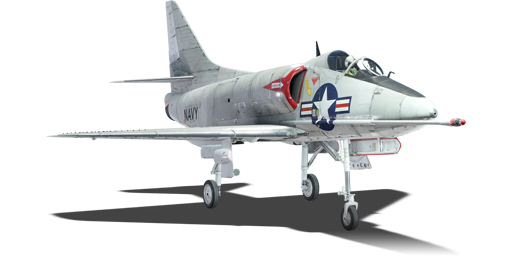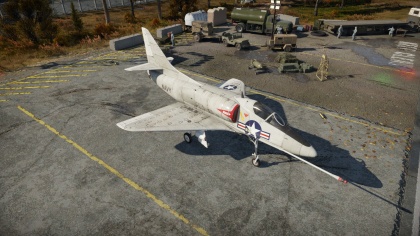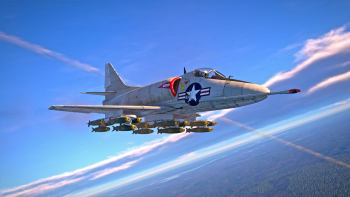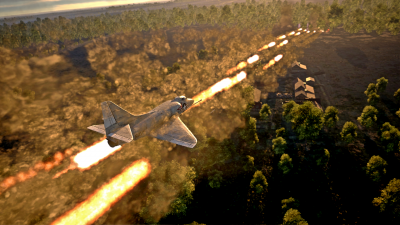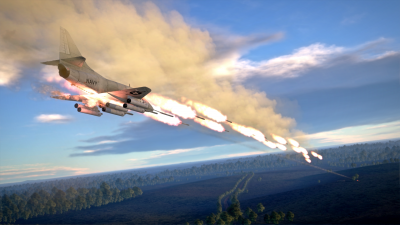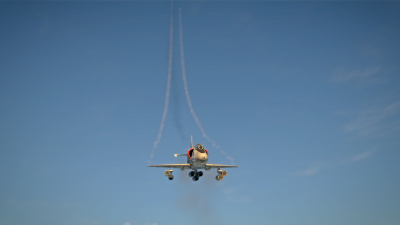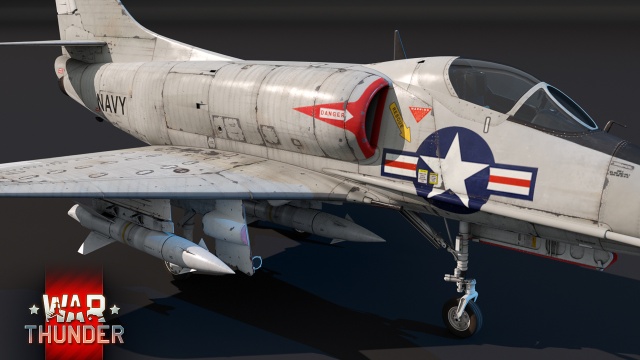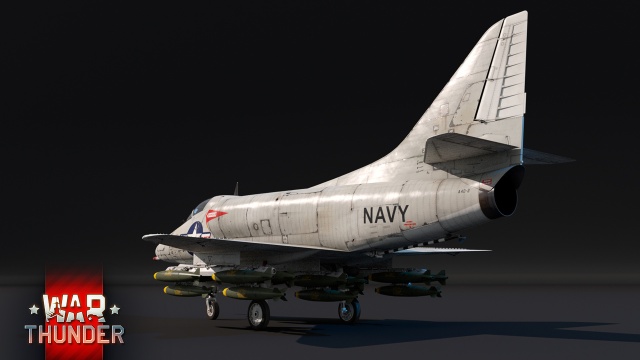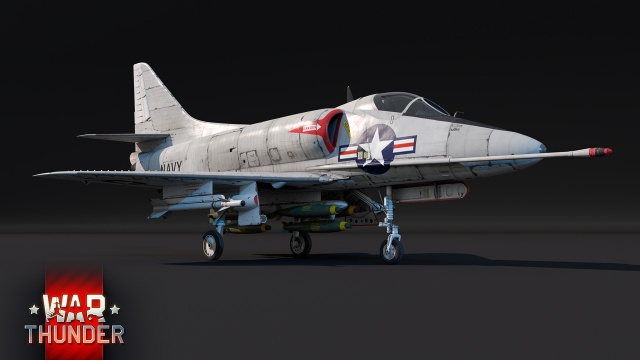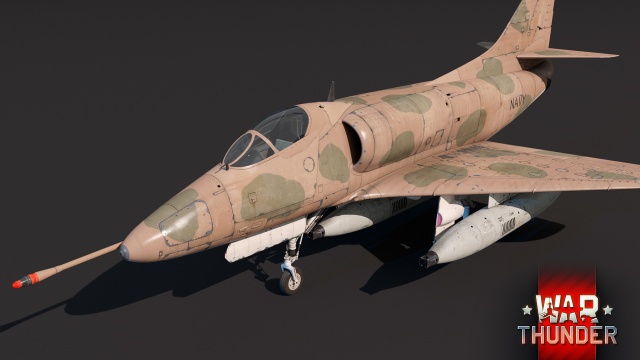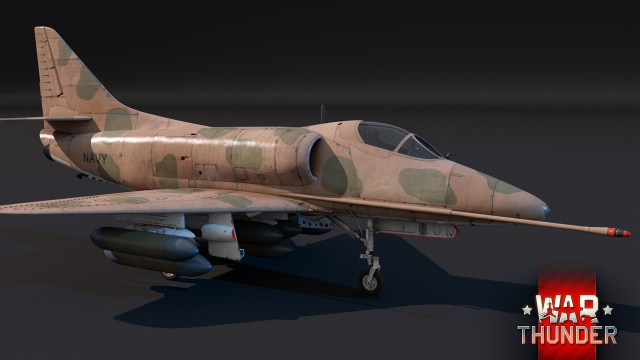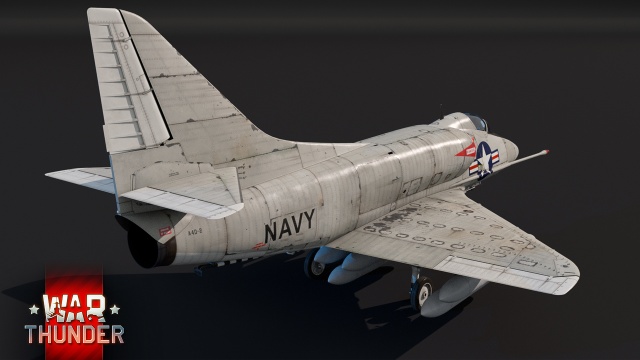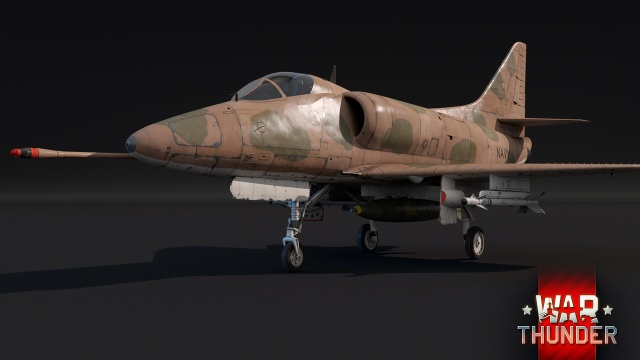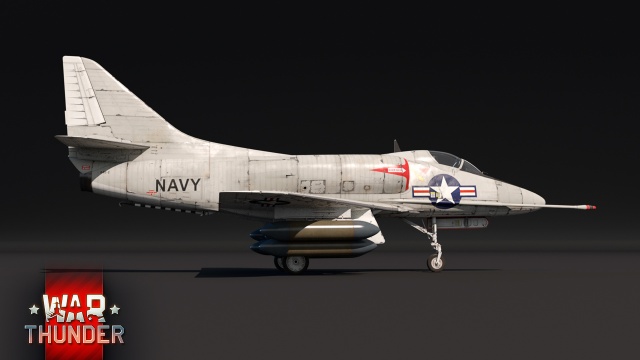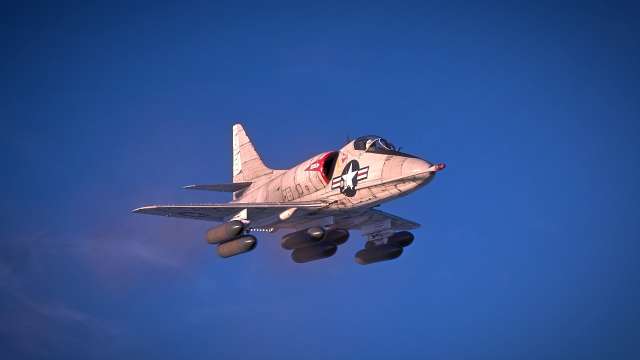Difference between pages "P-400" and "A-4B"
(Changed reference to note.) |
(Added images.) |
||
| Line 1: | Line 1: | ||
| − | {{Specs-Card | + | {{Specs-Card|code=a_4b}} |
| − | |code= | ||
| − | |||
| − | |||
| − | |||
| − | |||
| − | |||
| − | |||
| − | |||
| − | |||
| − | }} | ||
== Description == | == Description == | ||
<!-- ''In the description, the first part should be about the history of and the creation and combat usage of the aircraft, as well as its key features. In the second part, tell the reader about the aircraft in the game. Insert a screenshot of the vehicle, so that if the novice player does not remember the vehicle by name, he will immediately understand what kind of vehicle the article is talking about.'' --> | <!-- ''In the description, the first part should be about the history of and the creation and combat usage of the aircraft, as well as its key features. In the second part, tell the reader about the aircraft in the game. Insert a screenshot of the vehicle, so that if the novice player does not remember the vehicle by name, he will immediately understand what kind of vehicle the article is talking about.'' --> | ||
[[File:GarageImage_{{PAGENAME}}.jpg|420px|thumb|left]] | [[File:GarageImage_{{PAGENAME}}.jpg|420px|thumb|left]] | ||
| − | {{ | + | {{Break}} |
| − | The '''{{Specs|name}}''' is a rank {{Specs|rank}} American | + | The '''{{Specs|name}}''' is a rank {{Specs|rank}} American jet attacker {{Battle-rating}}. It was introduced in [[Update 1.97 "Viking Fury"]]. |
| − | The | + | The {{PAGENAME}} is an excellent aircraft for pilots who like to perform multiple roles without having to switch up aircraft. Possessing options to carry up to 5,000 lbs in bombs, 133 unguided rockets or five 20 mm autocannons with a total of 2,350 rounds of ammunition in what is effectively a "hot rod" of the jet world allows pilots to maximize their playstyle. |
| − | + | [[File:A-4B an trn 26 006.png|350px|thumb|left|A view of the suspended ordnance racks. Just one of the many options for the {{PAGENAME}}.]] | |
| + | |||
| + | Though the manoeuvrability suffers when fully loaded, this jet attacker operates well at mid and lower altitudes, especially when unloading bombs and rockets on ground-based targets. The Skyhawk's air-to-air capabilities are not forgotten; however, as in actual usage, the missiles and internal 20 mm autocannons were more for defensive purposes or for taking out targets of opportunity. With the sheer amount of rockets when loaded, especially the Mighty Mouse variants, it is best to fire them off in salvos to ensure maximum damage inflicted. | ||
| + | |||
| + | This aircraft's nickname is "Scooter" for a reason, though not the fastest aircraft in the battle, with its petite size and massive payload, it is not uncommon for the {{PAGENAME}} to scoot behind enemy lines and rain down destruction on ground targets before anyone realizes what is going on. Though small in size, the Skyhawk should not be underestimated and considered a significant threat. | ||
== General info == | == General info == | ||
| Line 26: | Line 20: | ||
{| class="wikitable" style="text-align:center" | {| class="wikitable" style="text-align:center" | ||
| − | + | ! rowspan="2" | Characteristics | |
| − | ! | + | ! colspan="2" | Max Speed<br>(km/h at 0 m - sea level) |
| − | + | ! rowspan="2" | Max altitude<br>(metres) | |
| − | |||
| − | |||
| − | ! colspan="2" | Max Speed<br>(km/h at | ||
| − | ! rowspan="2" | Max altitude<br>( | ||
! colspan="2" | Turn time<br>(seconds) | ! colspan="2" | Turn time<br>(seconds) | ||
| − | ! colspan="2" | Rate of climb<br>( | + | ! colspan="2" | Rate of climb<br>(metres/second) |
| − | ! rowspan="2" | Take-off run<br>( | + | ! rowspan="2" | Take-off run<br>(metres) |
|- | |- | ||
| − | ! AB | + | ! AB !! RB !! AB !! RB !! AB !! RB |
| − | ! RB | ||
| − | ! AB | ||
| − | ! RB | ||
| − | ! AB | ||
| − | ! RB | ||
|- | |- | ||
| − | | | + | ! Stock |
| + | | 874 || 865 || rowspan="2" | {{Specs|ceiling}} || 37.7 || 39.0 || 41.8 || 39.3 || rowspan="2" | 900 | ||
|- | |- | ||
| − | ! | + | ! Upgraded |
| − | + | | ___ || ___ || __._ || __._ || __._ || __._ | |
| − | |||
| − | |||
| − | |||
| − | |||
| − | |||
| − | |||
| − | |||
| − | |||
| − | |||
| − | |||
| − | |||
| − | |||
| − | |||
| − | | | ||
|- | |- | ||
|} | |} | ||
| Line 68: | Line 40: | ||
{| class="wikitable" style="text-align:center" | {| class="wikitable" style="text-align:center" | ||
|- | |- | ||
| − | ! colspan=" | + | ! colspan="6" | Features |
|- | |- | ||
| − | ! Combat flaps | + | ! Combat flaps !! Take-off flaps !! Landing flaps !! Air brakes !! Arrestor gear !! Drogue chute |
| − | ! Take-off flaps | ||
| − | ! Landing flaps | ||
| − | ! Air brakes | ||
| − | ! Arrestor gear | ||
|- | |- | ||
| − | | ✓ || ✓ || ✓ || | + | | ✓ || ✓ || ✓ || ✓ || ✓ || X <!-- ✓ --> |
|- | |- | ||
|} | |} | ||
| Line 82: | Line 50: | ||
{| class="wikitable" style="text-align:center" | {| class="wikitable" style="text-align:center" | ||
|- | |- | ||
| − | ! colspan=" | + | ! colspan="7" | Limits |
|- | |- | ||
| − | ! rowspan="2" | | + | ! rowspan="2" | Wings (km/h) |
| − | ! rowspan="2" | Gear | + | ! rowspan="2" | Gear (km/h) |
| − | ! | + | ! colspan="3" | Flaps (km/h) |
! colspan="2" | Max Static G | ! colspan="2" | Max Static G | ||
|- | |- | ||
| − | ! + | + | ! Combat !! Take-off !! Landing !! + !! - |
| − | ! - | ||
|- | |- | ||
| − | | {{Specs|destruction| | + | | {{Specs|destruction|body}} || {{Specs|destruction|gear}} || 615 || ___ || 410 || ~8 || ~3 |
|- | |- | ||
|} | |} | ||
| Line 98: | Line 65: | ||
{| class="wikitable" style="text-align:center" | {| class="wikitable" style="text-align:center" | ||
|- | |- | ||
| − | ! colspan="4" | Optimal velocities | + | ! colspan="4" | Optimal velocities (km/h) |
|- | |- | ||
| − | ! Ailerons | + | ! Ailerons !! Rudder !! Elevators !! Radiator |
| − | ! Rudder | ||
| − | ! Elevators | ||
| − | ! Radiator | ||
|- | |- | ||
| − | | < | + | | < 650 || < 700 || < 670 || N/A |
|- | |- | ||
|} | |} | ||
| − | + | === Survivability and armour === | |
| − | + | <!--''Examine the survivability of the aircraft. Note how vulnerable the structure is and how secure the pilot is, whether the fuel tanks are armoured, etc. Describe the armour, if there is any, and also mention the vulnerability of other critical aircraft systems.''--> | |
| − | + | ||
| − | + | The {{PAGENAME}}, designed to be a light-weight attack aircraft was half the weight of the Navy's design spec requirements. This initial weight savings meant that the plane did not have to skimp on pilot protection. Since the primary role of the aircraft is as an attacker, the pilot protection from the front and the underside is critical. From the front, the windshield portion of the canopy contains 50 mm bulletproof glass. Protective armour from the ground or naval based targets comes in the form of a 2.54 mm steel "tub" which the pilot's seat is situated in. The protective shield surrounds the pilot on all four sides (front, back, left and right) and makes up for most of the floor panelling, leaving room for the controls to go through. While the pilot is not invulnerable, the armour will provide a buffer for lighter calibre fire or shrapnel effects from missiles. The pilot does remain vulnerable to fighter aircraft approaching from above the cockpit. | |
| − | ! | ||
| − | |||
| − | |||
| − | |||
| − | |||
| − | |||
| − | |||
| − | |||
| − | |||
| − | + | There are three fuel tanks in the aircraft of which the two in the wings are non-self-sealing and pose a fire hazard if they catch on fire, however, the fuel tank situation directly behind the pilot is self-sealing. | |
| − | |||
| − | |||
| − | |||
| − | |||
| − | |||
| − | |||
| − | |||
| − | |||
| − | |||
| − | |||
| − | + | * 50 mm bulletproof glass | |
| − | * | + | * 2.54 mm Steel-plated "tub" |
| − | * | + | * Self-sealing fuel tank behind the pilot |
| + | * Non-self-sealing fuel tanks in the wings | ||
== Armaments == | == Armaments == | ||
=== Offensive armament === | === Offensive armament === | ||
| − | <!-- ''Describe the offensive armament of the aircraft, if any. Describe how effective the cannons and machine guns are in a battle, and also what belts or drums are better to use. If there is no offensive weaponry, delete this subsection.'' --> | + | <!--''Describe the offensive armament of the aircraft, if any. Describe how effective the cannons and machine guns are in a battle, and also what belts or drums are better to use. If there is no offensive weaponry, delete this subsection.''--> |
| − | {{main| | + | [[File:A-4B an trn 26 007.png|400px|thumb|right|A '''{{PAGENAME}}''' set up for air-to-air combat with its suspended centerline gunpod and AIM-9B Sidewinders.]] |
| + | |||
| + | {{main|Browning-Colt Mk12 Mod 3 (20 mm)}} | ||
| + | |||
| + | The {{PAGENAME}} is outfitted with the following offensive armament: | ||
| + | |||
| + | * 2 x 20 mm Browning-Colt Mk12 Mod 3 autocannons (100 RPG) | ||
| + | |||
| + | === Suspended armament === | ||
| + | <!--''Describe the aircraft's suspended armament: additional cannons under the wings, bombs, rockets and torpedoes. This section is especially important for bombers and attackers. If there is no suspended weaponry remove this subsection.''--> | ||
| + | [[File:A-4B an trn 26 003.png|400px|thumb|right|The 133 FFAR Mighty Mouse rockets effectively turns into a 70 mm autocannon which will not jam or overheat when fired as a salvo.]] | ||
| + | |||
| + | {{main|LDGP Mk 81 (250 lb)|LDGP Mk 82 (500 lb)|LDGP Mk 83 (1,000 lb)|LDGP Mk 84 (2,000 lb)|AIM-9B}} | ||
| + | {{main|FFAR Mighty Mouse|Zuni Mk32 Mod 0 ATAP|AGM-12B Bullpup|Mk 11 mod 5 (20 mm)}} | ||
| + | |||
| + | The {{PAGENAME}} can choose from a wide assortment of suspended armament combinations: | ||
| − | + | * 18 x 250 lb LDGP Mk 81 bombs (4,500 lb total) | |
| − | * 1 x | + | * 9 x 500 lb LDGP Mk 82 bombs (4,500 lb total) |
| − | * 2 x | + | * 5 x 1,000 lb LDGP Mk 83 bombs (5,000 lb total) |
| − | * | + | * 1 x 2,000 lb LDGP Mk 84 bomb (2,000 lb total) |
| + | * 3 x AGM-12B Bullpup rockets | ||
| + | * 133 x FFAR Mighty Mouse rockets | ||
| + | * 28 x Zuni Mk32 Mod 0 ATAP rockets | ||
| + | * 2 x AIM-9B Sidewinder Air-to-air missiles | ||
| + | * 76 x FFAR Mighty Mouse rockets + 5 x 500 lb LDGP Mk 82 bombs (2,500 lb total) | ||
| + | * 16 x Zuni Mk32 Mod 0 ATAP rockets + 6 x 250 lb LDGP Mk 81 bombs (1,500 lb total) | ||
| + | * 16 x Zuni Mk32 Mod 0 ATAP rockets + 5 x 500 lb LDGP Mk 82 bombs (2,500 lb total) | ||
| + | * 2 x AIM-9B Sidewinder Air-to-air missiles + 6 x 250 lb LDGP Mk 81 bombs (1,500 lb total) | ||
| + | * 2 x AIM-9B Sidewinder Air-to-air missiles + 5 x 500 lb LDGP Mk 82 bombs (2,500 lb total) | ||
| + | * 2 x AIM-9B Sidewinder Air-to-air missiles + 3 x 1,000 lb LDGP Mk 83 bombs (3,000 lb total) | ||
| + | * 2 x AIM-9B Sidewinder Air-to-air missiles + 1 x 2,000 lb LDGP Mk 84 bomb (2,000 lb total) | ||
| + | * 2 x AIM-9B Sidewinder Air-to-air missiles + 1 AGM-12B Bullpup rocket | ||
| + | * 2 x AIM-9B Sidewinder Air-to-air missiles + 57 FFAR Mighty Mouse rockets | ||
| + | * 2 x AIM-9B Sidewinder Air-to-air missiles + 12 x Zuni Mk32 Mod 0 ATAP rockets | ||
| + | * 3 x 20 mm Mk 11 mod 5 autocannons (750 RPG, 2,250 total rounds) | ||
| + | * 1 x 20 mm Mk 11 mod 5 autocannon (750 RPG) + 2 x AIM-9B Sidewinder Air-to-air missiles | ||
== Usage in battles == | == Usage in battles == | ||
| − | <!-- ''Describe the tactics of playing in | + | <!--''Describe the tactics of playing in the aircraft, the features of using aircraft in a team and advice on tactics. Refrain from creating a "guide" - do not impose a single point of view, but instead, give the reader food for thought. Examine the most dangerous enemies and give recommendations on fighting them. If necessary, note the specifics of the game in different modes (AB, RB, SB).''--> |
| − | + | ||
| + | The {{PAGENAME}} while designated by the U.S. Navy as an attacker can work as a multi-role aircraft. Though the variety of armament leans heavily to the attacker side, this aircraft also has a fighter side which can feel more like a hotrod compared to some of the other fighters out there such as the [[F-4C Phantom II|F-4]] coming in at 14-tonnes more massive. | ||
| + | |||
| + | ;Attacker | ||
| + | [[File:A-4B an trn 26 004.png|400px|thumb|right|Zuni rockets streaking towards their target.]] | ||
| + | The Douglas Aircraft Company built the {{PAGENAME}} from the ground up to be a small, fast and effective as an attack aircraft. While conventional wisdom would dictate that a larger aircraft would be necessary to carry enough suspended ordnance into battle to be effective, the Skyhawk shatters that myth. With only three hardpoints to attach ordnance to, specialized racks can extend the number of suspended weapons which the aircraft can carry. For instance, if using this aircraft to take out a mobile vehicle or anti-aircraft artillery, strapping on 18 x 250 lb bombs provides an opportunity to hit targets which may spread out or to divide ordnance between different clusters of targets. When attacking more heavily armoured targets or bases, the {{PAGENAME}} can choose to load up on 5 x 1,000 lb bombs or a single 2,000 lb bomb which creates considerable damage against ground targets. | ||
| − | + | Though bombs do a considerable amount of damage where they land, they are not the end-all answer to ground attack. Unguided rockets provide another option to the attacker-role of the aircraft. This aircraft has the option of loading up on 133 FFAR Mighty Mouse or 28 Zuni unguided rockets. When the pilot selects to fire these rockets in salvo mode, they have effectively turned their rockets into a large calibre autocannon which will not overhead or jam and continue to fire off rockets until the rocket tubes deplete of their ordnance. A salvo of Mighty Mouse rockets can also be extremely effective against aircraft or helicopters which may have a hard time getting out of the way when fired at from shorter distances. On domination maps, a salvo of rockets can make quick work of aircraft attempting to capture a runway. Bullpup rockets are another option; however, with only three loaded at a time, it is essential to be selective with the targets. To help with stabilizing the {{PAGENAME}} in a dive and while lining up targets, fuselage-mounted airbrakes can assist in preventing speed build up and stabilize the aircraft, however, once exiting an attack point, it is important to retract the airbrakes to allow for the aircraft to gain speed. | |
| − | + | ;Fighter | |
| − | + | Typically the {{PAGENAME}} was not used as a fighter; however, it carried armament which allowed it to defend itself or take on targets of opportunity. Always at its disposal is two 20 mm autocannons each with 100 rounds, however, these won't last too long in an extended engagement. Other options which allow the aircraft to flex its offensive muscles include AIM-9B Sidewinder missiles or suspended 20 mm gun pods. The AIM-9B provides the Skyhawk with a bit more reach allowing it to hit aircraft which may be faster or out of range of the guns. Typically, when launched from less than a mile away, the missile does not track to the target and instead fly off. For those pilots who enjoy fighting with aircraft guns, then the option to attach gun pods may be the way to go. Whether it is a single centerline gun pod or the addition of two more on each of the wing pylons, each suspended gun pod each contain 750 rounds of 20 mm ammunition. | |
| − | + | Due to the diversity of weapons options afforded to the {{PAGENAME}} and their various configurations, pilots can customize their payloads to meet both their playstyle and missions. For those who want to unload the maximum damage against ground targets can choose solely to load up on bombs or rockets, while those opting for air-to-air can choose missiles and guns. Some pilots may want to take a smaller ground-attack load while affording some air-to-air protection with missiles. There is no right or wrong selection; it all depends on the fighting style of the pilot. | |
| − | { | ||
| − | |||
| − | |||
| − | |||
| − | |||
| − | |||
| − | |||
| − | |||
| − | |||
| − | |||
| − | |||
| − | |||
| − | |||
| − | |||
| − | |||
| − | |||
| − | |||
=== Modules === | === Modules === | ||
{| class="wikitable" | {| class="wikitable" | ||
| − | ! | + | ! Tier |
| − | ! colspan="2" | Flight performance | + | ! colspan="2"|Flight performance |
| − | ! | + | ! Survivability |
| − | ! colspan=" | + | ! colspan="3" | Weaponry |
|- | |- | ||
| I | | I | ||
| − | | Fuselage repair | + | | Fuselage repair |
| − | | | + | | Compressor |
| − | | | + | | |
| − | | Offensive | + | | Offensive 20 mm cannons |
| − | | | + | | Mk81 |
| + | | AGM-12B Bullpup | ||
|- | |- | ||
| II | | II | ||
| − | | | + | | New boosters |
| − | | | + | | |
| Airframe | | Airframe | ||
| − | | | + | | |
| − | | | + | | Mk82 |
| + | | LAU-3/A | ||
|- | |- | ||
| III | | III | ||
| Wings repair | | Wings repair | ||
| Engine | | Engine | ||
| − | | | + | | |
| − | | | + | | New 20 mm cannons |
| − | | | + | | Mk83 |
| + | | LAU-10/A | ||
|- | |- | ||
| IV | | IV | ||
| − | | | + | | G-suit |
| − | | | + | | |
| Cover | | Cover | ||
| − | | | + | | Gunpod Mk 4 mod 0 |
| − | | | + | | Mk84 |
| + | | AIM-9B | ||
|- | |- | ||
|} | |} | ||
| − | |||
=== Pros and cons === | === Pros and cons === | ||
| − | <!-- ''Summarise and briefly evaluate the vehicle in terms of its characteristics and combat effectiveness. Mark its pros and cons in the bulleted list. Try not to use more than 6 points for each of the characteristics. Avoid using categorical definitions such as "bad", "good" and the like - use substitutions with softer forms such as "inadequate" and "effective".'' --> | + | <!--''Summarise and briefly evaluate the vehicle in terms of its characteristics and combat effectiveness. Mark its pros and cons in the bulleted list. Try not to use more than 6 points for each of the characteristics. Avoid using categorical definitions such as "bad", "good" and the like - use substitutions with softer forms such as "inadequate" and "effective".''--> |
'''Pros:''' | '''Pros:''' | ||
| − | * | + | * Small aircraft profile |
| − | * | + | * Wide variety armament options for air-to-ground, air-to-air or a mix of both |
| − | + | * Pilot protection with cockpit armour and bullet-proof windscreen | |
| − | * | + | * Very manoeuvrable with minimal suspended ordnance (or after ordnance has been expended) |
| − | * | + | * 20 mm autocannons mounted in the wing roots, convergence adjustment may come into play for extreme distance shots |
| − | |||
| − | |||
| − | |||
| − | |||
| − | |||
| − | |||
| − | '''Cons:''' | + | '''Cons:''' |
| − | * | + | * Air-to-ground ordnance mounted under the wings negatively affect roll rate |
| − | * | + | * Fully loaded with ordnance makes it difficult to evade if necessary |
| − | * | + | * Average speed, can reach Mach 1 in an extended dive with WEP |
| − | * | + | * Requires air-brakes to land on an aircraft carrier |
| − | + | * High stall speed | |
| − | |||
| − | |||
| − | * | ||
== History == | == History == | ||
| − | ''Describe the history of the creation and combat usage of the aircraft in more detail than in the introduction. If the historical reference turns out to be too long, take it to a separate article, taking a link to the article about the vehicle and adding a block "/ History" (example: <nowiki>https://wiki.warthunder.com/(Vehicle-name)/History</nowiki>) and add a link to it here using the <code>main</code> template. Be sure to reference text and sources by using <code><nowiki><ref></ref></nowiki></code>, as well as adding them at the end of the article with <code><nowiki><references /></nowiki></code>. This section may also include the | + | <!--''Describe the history of the creation and combat usage of the aircraft in more detail than in the introduction. If the historical reference turns out to be too long, take it to a separate article, taking a link to the article about the vehicle and adding a block "/History" (example: <nowiki>https://wiki.warthunder.com/(Vehicle-name)/History</nowiki>) and add a link to it here using the <code>main</code> template. Be sure to reference text and sources by using <code><nowiki><ref></ref></nowiki></code>, as well as adding them at the end of the article with <code><nowiki><references /></nowiki></code>. This section may also include the vehicle's dev blog entry (if applicable) and the in-game encyclopedia description (under <code><nowiki>=== In-game description ===</nowiki></code>, also if applicable).''--> |
| + | [[File:A-4B an trn 26 002.png|400px|thumb|right|]] | ||
| + | At a time when military aircraft were becoming more substantial in size to hold larger engines, more weapons, essential fuel and new technology, Douglas Aircraft's concept of the A-4 Skyhawk seemed counter-intuitive. The A-1 Skyraider, while a potent aircraft was starting to age out of the service as faster jets began to supplant the propeller-driven attacker. In the early 1950s, the U.S. Navy began its search for the next generation attacker and put out a requirement for an attacker with a maximum cost of $1 million and a maximum empty weight of 20,000 lbs (9,071 kg) and could carry enough ammunition to at least compete with the older but beefy A-1. | ||
| − | + | Ed Heinemann, a designer at Douglas Aircraft Company, responded with the XA4D-1 attack aircraft. Contrary to conventional wisdom, Heinemann's design focused on an attack aircraft which would be minimal in size and weight along with being a simple aircraft to maintain. Douglas Aircraft succeeded in winning the contract and what became known by nicknames such as "Scooter" or "Bantam Bomber", the XA4D-1 (later changed to A-4) was a winning solution to the Navy's needs. The resulting attack aircraft came in at just over $850,000 each while weighing half of what was the Navy's original specification, owing to weight savings with the wings, being as short as they were, there was no need for them to fold to save space while stowed on an aircraft carrier. "Scooter" was an appropriate nickname for the A-4 as its original prototype set a world speed record in 1955 with a speed of 695.163 mph (1,118.756 km/h). | |
| − | |||
| − | The aircraft was | + | The A-4 though small in size, did not differ much in design from other military aircraft of the day. The wing was a low-mounted delta shape which had single forge spars which spanned to both wingtips for extra strength. Tricycle configuration for the landing gear allowed the nose to remain relatively low for excellent pilot visibility mainly when operating on the deck of an aircraft carrier. A single turbo-jet engine mounted at the rear of the aircraft was fed by two air intakes located just behind the cockpit on each side of the fuselage. Offensive weapons for this aircraft consisted of two 20 mm Browning-Colt Mk12 Mod 3 autocannons, each one located in a wing root. Only 100 rounds are available for each gun. Still, a single fuselage centerline hardpoint and a hardpoint under each wing allow for utilisation of a wide variety of missiles, rockets, bombs and gun pods. |
| − | + | At the start of the Vietnam War, the A-4 Skyhawk was the primary light bomber for the Navy. A total of 542 A-4Bs were built and delivered to the Navy. Upgrades over the A-4A consisted of improved navigation equipment and flight control systems. AGM-12 Bullpup missiles were also a new weapon for this aircraft. The Skyhawk also utilised the AIM-9B Sidewinder missiles; however, these were mostly used as a defensive weapon and rarely for offensive purposes. | |
| − | The | + | The A-4 is a rugged little attack aircraft which remained in service with both the U.S. Navy and United States Marine Corps for over 20 years before being retired. However, more than sixty years after initial operations began, the Skyhawk is only now still in service with the Brazilian Navy. |
| − | + | == Media == | |
| − | + | <!--''Excellent additions to the article would be video guides, screenshots from the game, and photos.''--> | |
| − | + | ;Images | |
| − | + | <gallery mode="packed"> | |
| − | + | File:A-4B WTWallpaper 001.jpg | |
| − | + | File:A-4B WTWallpaper 002.jpg | |
| − | + | File:A-4B WTWallpaper 003.jpg | |
| − | + | File:A-4B WTWallpaper 004.jpg | |
| − | + | File:A-4B WTWallpaper 005.jpg | |
| − | + | File:A-4B WTWallpaper 006.jpg | |
| − | + | File:A-4B WTWallpaper 007.jpg | |
| + | File:A-4B WTWallpaper 008.jpg | ||
| + | File:A-4B an trn 26 001.png | ||
| + | </gallery> | ||
| − | + | ;Videos | |
| − | + | {{Youtube-gallery|NWhJ5-ar0aU|'''THE HAWK OF THE SKIES...Literally''' - ''Sgt.Vittie''|2-a9gkeZNc0|'''Maximum Rush /// A-4B Skyhawk''' - ''DEFYN''}} | |
| − | |||
| − | |||
| − | |||
| − | |||
| − | |||
| − | |||
== See also == | == See also == | ||
''Links to the articles on the War Thunder Wiki that you think will be useful for the reader, for example:'' | ''Links to the articles on the War Thunder Wiki that you think will be useful for the reader, for example:'' | ||
| + | |||
* ''reference to the series of the aircraft;'' | * ''reference to the series of the aircraft;'' | ||
* ''links to approximate analogues of other nations and research trees.'' | * ''links to approximate analogues of other nations and research trees.'' | ||
| − | |||
| − | |||
| − | |||
== External links == | == External links == | ||
| − | + | <!--Paste links to sources and external resources, such as: | |
* ''topic on the official game forum;'' | * ''topic on the official game forum;'' | ||
* ''encyclopedia page on the aircraft;'' | * ''encyclopedia page on the aircraft;'' | ||
| − | * ''other literature.'' | + | * ''other literature.''--> |
| + | |||
| + | * [[wt:en/news/6597-development-douglas-a-4b-skyhawk-a-story-of-simplicity-en|[Devblog] Douglas A-4B Skyhawk: A Story of Simplicity]] | ||
| + | * [[wikipedia:Douglas_A-4_Skyhawk|[Wikipedia] Douglas A-4 Skyhawk]] | ||
| − | {{AirManufacturer | + | {{AirManufacturer Douglas}} |
| − | {{USA | + | {{USA jet aircraft}} |
Revision as of 15:41, 17 April 2020
Contents
Description
The A-4B Skyhawk is a rank VI American jet attacker
with a battle rating of 9.0 (AB/SB) and 8.7 (RB). It was introduced in Update 1.97 "Viking Fury".
The A-4B is an excellent aircraft for pilots who like to perform multiple roles without having to switch up aircraft. Possessing options to carry up to 5,000 lbs in bombs, 133 unguided rockets or five 20 mm autocannons with a total of 2,350 rounds of ammunition in what is effectively a "hot rod" of the jet world allows pilots to maximize their playstyle.
Though the manoeuvrability suffers when fully loaded, this jet attacker operates well at mid and lower altitudes, especially when unloading bombs and rockets on ground-based targets. The Skyhawk's air-to-air capabilities are not forgotten; however, as in actual usage, the missiles and internal 20 mm autocannons were more for defensive purposes or for taking out targets of opportunity. With the sheer amount of rockets when loaded, especially the Mighty Mouse variants, it is best to fire them off in salvos to ensure maximum damage inflicted.
This aircraft's nickname is "Scooter" for a reason, though not the fastest aircraft in the battle, with its petite size and massive payload, it is not uncommon for the A-4B to scoot behind enemy lines and rain down destruction on ground targets before anyone realizes what is going on. Though small in size, the Skyhawk should not be underestimated and considered a significant threat.
General info
Flight performance
Describe how the aircraft behaves in the air. Speed, manoeuvrability, acceleration and allowable loads - these are the most important characteristics of the vehicle.
| Characteristics | Max Speed (km/h at 0 m - sea level) |
Max altitude (metres) |
Turn time (seconds) |
Rate of climb (metres/second) |
Take-off run (metres) | |||
|---|---|---|---|---|---|---|---|---|
| AB | RB | AB | RB | AB | RB | |||
| Stock | 874 | 865 | 12500 | 37.7 | 39.0 | 41.8 | 39.3 | 900 |
| Upgraded | ___ | ___ | __._ | __._ | __._ | __._ | ||
Details
| Features | |||||
|---|---|---|---|---|---|
| Combat flaps | Take-off flaps | Landing flaps | Air brakes | Arrestor gear | Drogue chute |
| ✓ | ✓ | ✓ | ✓ | ✓ | X |
| Limits | ||||||
|---|---|---|---|---|---|---|
| Wings (km/h) | Gear (km/h) | Flaps (km/h) | Max Static G | |||
| Combat | Take-off | Landing | + | - | ||
| 1167 | 437 | 615 | ___ | 410 | ~8 | ~3 |
| Optimal velocities (km/h) | |||
|---|---|---|---|
| Ailerons | Rudder | Elevators | Radiator |
| < 650 | < 700 | < 670 | N/A |
Survivability and armour
The A-4B, designed to be a light-weight attack aircraft was half the weight of the Navy's design spec requirements. This initial weight savings meant that the plane did not have to skimp on pilot protection. Since the primary role of the aircraft is as an attacker, the pilot protection from the front and the underside is critical. From the front, the windshield portion of the canopy contains 50 mm bulletproof glass. Protective armour from the ground or naval based targets comes in the form of a 2.54 mm steel "tub" which the pilot's seat is situated in. The protective shield surrounds the pilot on all four sides (front, back, left and right) and makes up for most of the floor panelling, leaving room for the controls to go through. While the pilot is not invulnerable, the armour will provide a buffer for lighter calibre fire or shrapnel effects from missiles. The pilot does remain vulnerable to fighter aircraft approaching from above the cockpit.
There are three fuel tanks in the aircraft of which the two in the wings are non-self-sealing and pose a fire hazard if they catch on fire, however, the fuel tank situation directly behind the pilot is self-sealing.
- 50 mm bulletproof glass
- 2.54 mm Steel-plated "tub"
- Self-sealing fuel tank behind the pilot
- Non-self-sealing fuel tanks in the wings
Armaments
Offensive armament
The A-4B is outfitted with the following offensive armament:
- 2 x 20 mm Browning-Colt Mk12 Mod 3 autocannons (100 RPG)
Suspended armament
The A-4B can choose from a wide assortment of suspended armament combinations:
- 18 x 250 lb LDGP Mk 81 bombs (4,500 lb total)
- 9 x 500 lb LDGP Mk 82 bombs (4,500 lb total)
- 5 x 1,000 lb LDGP Mk 83 bombs (5,000 lb total)
- 1 x 2,000 lb LDGP Mk 84 bomb (2,000 lb total)
- 3 x AGM-12B Bullpup rockets
- 133 x FFAR Mighty Mouse rockets
- 28 x Zuni Mk32 Mod 0 ATAP rockets
- 2 x AIM-9B Sidewinder Air-to-air missiles
- 76 x FFAR Mighty Mouse rockets + 5 x 500 lb LDGP Mk 82 bombs (2,500 lb total)
- 16 x Zuni Mk32 Mod 0 ATAP rockets + 6 x 250 lb LDGP Mk 81 bombs (1,500 lb total)
- 16 x Zuni Mk32 Mod 0 ATAP rockets + 5 x 500 lb LDGP Mk 82 bombs (2,500 lb total)
- 2 x AIM-9B Sidewinder Air-to-air missiles + 6 x 250 lb LDGP Mk 81 bombs (1,500 lb total)
- 2 x AIM-9B Sidewinder Air-to-air missiles + 5 x 500 lb LDGP Mk 82 bombs (2,500 lb total)
- 2 x AIM-9B Sidewinder Air-to-air missiles + 3 x 1,000 lb LDGP Mk 83 bombs (3,000 lb total)
- 2 x AIM-9B Sidewinder Air-to-air missiles + 1 x 2,000 lb LDGP Mk 84 bomb (2,000 lb total)
- 2 x AIM-9B Sidewinder Air-to-air missiles + 1 AGM-12B Bullpup rocket
- 2 x AIM-9B Sidewinder Air-to-air missiles + 57 FFAR Mighty Mouse rockets
- 2 x AIM-9B Sidewinder Air-to-air missiles + 12 x Zuni Mk32 Mod 0 ATAP rockets
- 3 x 20 mm Mk 11 mod 5 autocannons (750 RPG, 2,250 total rounds)
- 1 x 20 mm Mk 11 mod 5 autocannon (750 RPG) + 2 x AIM-9B Sidewinder Air-to-air missiles
Usage in battles
The A-4B while designated by the U.S. Navy as an attacker can work as a multi-role aircraft. Though the variety of armament leans heavily to the attacker side, this aircraft also has a fighter side which can feel more like a hotrod compared to some of the other fighters out there such as the F-4 coming in at 14-tonnes more massive.
- Attacker
The Douglas Aircraft Company built the A-4B from the ground up to be a small, fast and effective as an attack aircraft. While conventional wisdom would dictate that a larger aircraft would be necessary to carry enough suspended ordnance into battle to be effective, the Skyhawk shatters that myth. With only three hardpoints to attach ordnance to, specialized racks can extend the number of suspended weapons which the aircraft can carry. For instance, if using this aircraft to take out a mobile vehicle or anti-aircraft artillery, strapping on 18 x 250 lb bombs provides an opportunity to hit targets which may spread out or to divide ordnance between different clusters of targets. When attacking more heavily armoured targets or bases, the A-4B can choose to load up on 5 x 1,000 lb bombs or a single 2,000 lb bomb which creates considerable damage against ground targets.
Though bombs do a considerable amount of damage where they land, they are not the end-all answer to ground attack. Unguided rockets provide another option to the attacker-role of the aircraft. This aircraft has the option of loading up on 133 FFAR Mighty Mouse or 28 Zuni unguided rockets. When the pilot selects to fire these rockets in salvo mode, they have effectively turned their rockets into a large calibre autocannon which will not overhead or jam and continue to fire off rockets until the rocket tubes deplete of their ordnance. A salvo of Mighty Mouse rockets can also be extremely effective against aircraft or helicopters which may have a hard time getting out of the way when fired at from shorter distances. On domination maps, a salvo of rockets can make quick work of aircraft attempting to capture a runway. Bullpup rockets are another option; however, with only three loaded at a time, it is essential to be selective with the targets. To help with stabilizing the A-4B in a dive and while lining up targets, fuselage-mounted airbrakes can assist in preventing speed build up and stabilize the aircraft, however, once exiting an attack point, it is important to retract the airbrakes to allow for the aircraft to gain speed.
- Fighter
Typically the A-4B was not used as a fighter; however, it carried armament which allowed it to defend itself or take on targets of opportunity. Always at its disposal is two 20 mm autocannons each with 100 rounds, however, these won't last too long in an extended engagement. Other options which allow the aircraft to flex its offensive muscles include AIM-9B Sidewinder missiles or suspended 20 mm gun pods. The AIM-9B provides the Skyhawk with a bit more reach allowing it to hit aircraft which may be faster or out of range of the guns. Typically, when launched from less than a mile away, the missile does not track to the target and instead fly off. For those pilots who enjoy fighting with aircraft guns, then the option to attach gun pods may be the way to go. Whether it is a single centerline gun pod or the addition of two more on each of the wing pylons, each suspended gun pod each contain 750 rounds of 20 mm ammunition.
Due to the diversity of weapons options afforded to the A-4B and their various configurations, pilots can customize their payloads to meet both their playstyle and missions. For those who want to unload the maximum damage against ground targets can choose solely to load up on bombs or rockets, while those opting for air-to-air can choose missiles and guns. Some pilots may want to take a smaller ground-attack load while affording some air-to-air protection with missiles. There is no right or wrong selection; it all depends on the fighting style of the pilot.
Modules
| Tier | Flight performance | Survivability | Weaponry | |||
|---|---|---|---|---|---|---|
| I | Fuselage repair | Compressor | Offensive 20 mm cannons | Mk81 | AGM-12B Bullpup | |
| II | New boosters | Airframe | Mk82 | LAU-3/A | ||
| III | Wings repair | Engine | New 20 mm cannons | Mk83 | LAU-10/A | |
| IV | G-suit | Cover | Gunpod Mk 4 mod 0 | Mk84 | AIM-9B | |
Pros and cons
Pros:
- Small aircraft profile
- Wide variety armament options for air-to-ground, air-to-air or a mix of both
- Pilot protection with cockpit armour and bullet-proof windscreen
- Very manoeuvrable with minimal suspended ordnance (or after ordnance has been expended)
- 20 mm autocannons mounted in the wing roots, convergence adjustment may come into play for extreme distance shots
Cons:
- Air-to-ground ordnance mounted under the wings negatively affect roll rate
- Fully loaded with ordnance makes it difficult to evade if necessary
- Average speed, can reach Mach 1 in an extended dive with WEP
- Requires air-brakes to land on an aircraft carrier
- High stall speed
History
At a time when military aircraft were becoming more substantial in size to hold larger engines, more weapons, essential fuel and new technology, Douglas Aircraft's concept of the A-4 Skyhawk seemed counter-intuitive. The A-1 Skyraider, while a potent aircraft was starting to age out of the service as faster jets began to supplant the propeller-driven attacker. In the early 1950s, the U.S. Navy began its search for the next generation attacker and put out a requirement for an attacker with a maximum cost of $1 million and a maximum empty weight of 20,000 lbs (9,071 kg) and could carry enough ammunition to at least compete with the older but beefy A-1.
Ed Heinemann, a designer at Douglas Aircraft Company, responded with the XA4D-1 attack aircraft. Contrary to conventional wisdom, Heinemann's design focused on an attack aircraft which would be minimal in size and weight along with being a simple aircraft to maintain. Douglas Aircraft succeeded in winning the contract and what became known by nicknames such as "Scooter" or "Bantam Bomber", the XA4D-1 (later changed to A-4) was a winning solution to the Navy's needs. The resulting attack aircraft came in at just over $850,000 each while weighing half of what was the Navy's original specification, owing to weight savings with the wings, being as short as they were, there was no need for them to fold to save space while stowed on an aircraft carrier. "Scooter" was an appropriate nickname for the A-4 as its original prototype set a world speed record in 1955 with a speed of 695.163 mph (1,118.756 km/h).
The A-4 though small in size, did not differ much in design from other military aircraft of the day. The wing was a low-mounted delta shape which had single forge spars which spanned to both wingtips for extra strength. Tricycle configuration for the landing gear allowed the nose to remain relatively low for excellent pilot visibility mainly when operating on the deck of an aircraft carrier. A single turbo-jet engine mounted at the rear of the aircraft was fed by two air intakes located just behind the cockpit on each side of the fuselage. Offensive weapons for this aircraft consisted of two 20 mm Browning-Colt Mk12 Mod 3 autocannons, each one located in a wing root. Only 100 rounds are available for each gun. Still, a single fuselage centerline hardpoint and a hardpoint under each wing allow for utilisation of a wide variety of missiles, rockets, bombs and gun pods.
At the start of the Vietnam War, the A-4 Skyhawk was the primary light bomber for the Navy. A total of 542 A-4Bs were built and delivered to the Navy. Upgrades over the A-4A consisted of improved navigation equipment and flight control systems. AGM-12 Bullpup missiles were also a new weapon for this aircraft. The Skyhawk also utilised the AIM-9B Sidewinder missiles; however, these were mostly used as a defensive weapon and rarely for offensive purposes.
The A-4 is a rugged little attack aircraft which remained in service with both the U.S. Navy and United States Marine Corps for over 20 years before being retired. However, more than sixty years after initial operations began, the Skyhawk is only now still in service with the Brazilian Navy.
Media
- Images
- Videos
See also
Links to the articles on the War Thunder Wiki that you think will be useful for the reader, for example:
- reference to the series of the aircraft;
- links to approximate analogues of other nations and research trees.
External links
| Douglas Aircraft Company | |
|---|---|
| Strike Aircraft | A-20G-25 · A-26B-10 · A-26B-50 · AD-2 · AD-4 · A-1H |
| Bombers | TBD-1 · B-18A · SBD-3 · BTD-1 · A-26C-45 · A-26C-45DT |
| Turboprops | A2D-1 |
| Jet Aircraft | F3D-1 · F4D-1 |
| A-4 Skyhawk | A-4B · A-4E Early |
| Export | ▄Havoc Mk I · ▄Boston Mk I · ▄DB-7 · ▂A-20G-30 · ▄AD-4 · ▄AD-4NA |
| A-4 Skyhawk | A-4H · A-4E Early (M) · Ayit · A-4E |
| The Douglas Aircraft Company merged with McDonnell Aircraft Corporation in 1967 to form McDonnell Douglas. | |
| USA jet aircraft | |
|---|---|
| Fighters | |
| F-4 | F-4C Phantom II · F-4E Phantom II · F-4J Phantom II · F-4S Phantom II |
| F-5 | F-5A · F-5C · F-5E · F-20A |
| F-8 | F8U-2 · F-8E |
| F-80 | F-80A-5 · F-80C-10 |
| F-84 | F-84B-26 · F-84F · F-84G-21-RE |
| F-86 | F-86A-5 · F-86F-25 · F-86F-2 · F-86F-35 |
| F-89 | F-89B · F-89D |
| F-100 | F-100D |
| F-104 | F-104A · F-104C |
| F-14 | F-14A Early · F-14B |
| F-15 | F-15A |
| F-16 | F-16A · F-16A ADF · F-16C |
| F9F | F9F-2 · F9F-5 · F9F-8 |
| Other | P-59A · F2H-2 · F3D-1 · F3H-2 · F4D-1 · F11F-1 |
| Strike Aircraft | |
| FJ-4 | FJ-4B · FJ-4B VMF-232 |
| A-4 | A-4B · A-4E Early |
| A-6 | A-6E TRAM |
| A-7 | A-7D · A-7E · A-7K |
| AV-8 | AV-8A · AV-8C |
| A-10 | A-10A · A-10A Late |
| B-57 | B-57A · B-57B |
| F-105 | F-105D |
| F-111 | F-111A |


